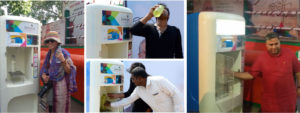What is a water ATM?« Back to Questions List
|
Water ATMs are automated water dispensing units that offer smart drinking water solutions. Water ATMs leverage technology to provide 24x7 safe drinking water facilities. Providing affordable access to safe drinking water in underserved areas is the objective behind Water ATMs. Sarvjal and Janajal are two initiatives in this regard. So far, drinking water requirements in deserving areas were mainly being met as part of CSR initiatives (Corporate Social Responsibility) of companies. In such initiatives, water was being supplied free to consumers without any charge. But through water ATMs, social enterprises are aiming a self-sustainable model or profit generation model. This model is evolving as a feasible solution for those consumers who find it difficult to afford bottled drinking water. Water ATMs find wide acceptability at bus stands, market places, hospitals and public locations with high footfall. Payment for water reduces wastage of water, a resource that is becoming scarce in many part of the country. Sarvajal is an initiative started in 2008 by Piramal foundation. Sarvajal is a pioneer in the field of evolving technologies and business models in the safe drinking water sector . They aim to have self-sustainable market model applicable in both rural and urban areas. As of now, around 3,00,000 consumers use the facility per day through 570+ water ATMS installed in 12 states of India. Janajal is another three year old, for-profit water utility social enterprise. They have installed 40 water ATMs and are in the process of installing another 39 at various railway stations. As per their business model, for Rs. 5, a consumer can collect 20 litres of water. In water ATMs all types of payments including debit cards, credit cards and digital payments are enabled. They are in the process of launching water cards that can be used in water ATMs in different locations. What is a water hole?How does groundwater get accumulated? |

